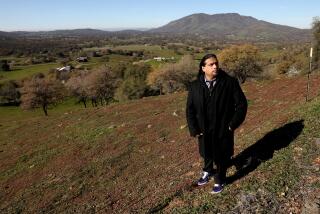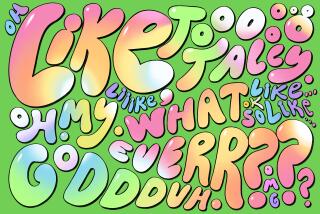When It Comes to Saying Simi, There’s a Pronounced Difference
- Share via
SIMI VALLEY — Just as you can distinguish a Southerner from a Bostonian by the shape of their vowels and consonants, so too can you tell a longtime resident of this city from a more recent immigrant.
Old-timers--those who can remember livery stables on Los Angeles Avenue and days spent picking wildflowers near the Santa Susana Pass--fervently say “Simi” should be pronounced Si-MEE, with the stress on the second vowel.
More recent transplants, however, are more apt to say SEE-me, which to just about every longtime resident sounds like fingernails on a blackboard.
With the city on the cusp of the 21st century, the old way is quickly disappearing, residents say. As the population grows, there are fewer original residents to defend the traditional pronunciation.
“I’ve almost gotten to a point where I think it’s impossible to educate them,” said 90-year-old Mavy Cormode with more than a hint of disdain. “There’s so many of them these days and they’ll just say it any way they want.”
Diane Walgreave, who moved to Simi Valley in 1985 and has been schooled more than once on the pronunciation, said she will stick with the SEE-me pronunciation because saying it the other way “is a little weird.”
So which is it? SEE-me or Si-MEE?
Pat Havens, the area’s unofficial historian, says it’s the latter--and she has the documents to prove it.
“It’s just plain wrong to say it SEE-me,” she said. “We’ve got documentation dating back a couple hundred years that show it’s pronounced Si-MEE.”
According to Havens, the word “Simi” came from the name of an old Chumash village, Shimiyi, that was located in the valley on the west end of town near what is today Madera Road.
Loosely translated, Shimiyi means “little wind cloud,” and probably came from the slender, thread-like clouds that sometimes stretch south from the valley during the fall.
In 1795 Santiago Pico, an officer in the Spanish army, was granted 113,000 acres in what is now Simi Valley and Moorpark and established the sprawling El Rancho Simi to raise sheep and cattle.
Two years later, the San Fernando Mission was established. It sent priests 20 miles north to the rancho to convert the local Chumash to Catholicism.
It was during this time that both Pico and the mission priests made written reference to El Rancho Simi with an accent placed on the last vowel of Simi, which leads Havens to think that the village Shimiyi was pronounced similarly.
“I’m sure the priests listened to the Chumash and spelled out the name of the rancho the way it was traditionally pronounced,” she said.
Havens added that the correct pronunciation was used up until the 1960s, when the population began to grow dramatically with development.
Anxious real-estate agents, who only knew the area as a place where quick profits could be made, began referring to the area as SEE-me Valley--and so did its new residents, said Havens.
But that might have to do just as much with the peculiarities of the English language as it does with ignorance.
Irene Clark, director of the University of Southern California’s Writing Program, said that while there are plenty of exceptions to the rule, English usually places the stress on the first vowel of every multi-voweled word, thus making Si-MEE about as unnatural to say as Gesundheit.
“We all have a habit of Americanizing foreign words,” Clark said.
And in the 30 or so years since, the incorrect pronunciation appears to have stuck and has even been used as a mildly clever play on words by some local business owners.
“Most of the people I deal with say SEE-me--even I do it,” said Colen Neal, an employee at See-Me Auto Repair on Sycamore Drive. “But I’ve heard it said a lot of different ways, so I’m not sure what’s right.”
Neal said the shop does plan on changing its name next month. The change, however, will not reflect the correct spelling or pronunciation. It will be renamed See-Me Smog.
Other residents like Walgreave still staunchly refuse to say it correctly simply because they think it’s easier the wrong way.
“It’s sounds weird when you try to say it like that,” Walgreave said repeating Si-MEE Valley several times. “If I said it like that I’d always have to stop and think.”
And putting the accent on the final “i” also sounds a little hoity-toity to some.
“The way I see it, if most people say it like SEE-me then that’s the way it should be said,” said Nap Crowe. “I don’t want to be different.”
It’s that kind of opinion that makes Irene Runkle-Gates’ blood boil.
“You know, when people say it like it’s like ‘Seamy Valley,’ like there’s a bunch of poor trashy people here and that isn’t right,” the 90-year-old longtime resident said. “I refuse to even say it like that, it bothers me so much.”
Mayor Greg Stratton said he learned the original way a long time ago and said he uses it as a barometer to tell how long a person has been a resident.
“If they say SEE-me, you can be pretty sure they’re [a] fairly new resident, but if they say it right you know they’ve been here awhile,” he said.
However, as the number of people who insist on saying Simi Valley in the manner it was intended dwindles, it appears as if SEE-me Valley is here to stay--and will soon be universally accepted as the city’s rightful name.
“I’ve heard it said wrong so many times it doesn’t bother that much anymore,” said Havens, whose own son even says it “the other way.”
“But, I have to say that I get so happy when I hear someone say it right. . . . It gives me hope.”
More to Read
Sign up for Essential California
The most important California stories and recommendations in your inbox every morning.
You may occasionally receive promotional content from the Los Angeles Times.













